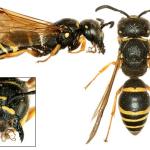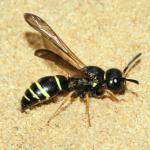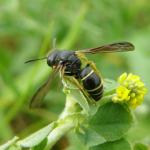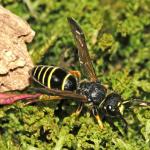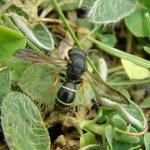Identification keys and general biology are given in Bristowe (1948), Danks (1971), Spradbery (1973), Richards (1980), Yeo & Corbet (1995) and Archer (2000).
Cornwall to Kent and north to Nottinghamshire and East Norfolk, with an isolated record from Westmorland.
Overseas found in many parts of Europe (Norway, Sweden, Finland, Denmark, The Netherlands, Luxembourg, France, Spain, Germany, Italy, Poland, Austria, Hungary, Slovenia, Albania and Romania); in Asia (Georgia, Armenia and far-eastern Russia) and in north Africa (Algeria).
This species is not regarded as being scarce or threatened. However, the relative lack of records since 1970 indicates that this species has recently undergone a significant decline, especially in the northern part of its range, so that its status may need to be reconsidered.
Found in a wide variety of open habitats, associated with its nesting and feeding sites and prey habitats.
Univoltine; recorded from May until September, with males mostly found from late May and June, and females during June and July.
Weevil larvae of the genera Hypera (Curculionidae).
A tube-dweller forming a series of 4-12 linearly arranged cells separated by clay partitions in hollow plant stems, e.g. bramble, burdock, elder and thistles. An egg is laid in the cell before about 20 weevil larvae are added.
Wild angelica, ash, bramble, buttercup, carrot, figwort and spurge.
The chalcidoid parasitoid Melittobia acasta (Walker) and an ichneumonid parasitoid, Bathyplectes (= Canidiella) species, are associated with Gymnomerus. The female Melittobia enters a cell of G. laevipes, punctures the cuticle of the larva with its ovipositor and feeds on the haemolymph released. Eggs are laid on the cuticle of the larval host. On hatching, the young wasp larvae pierce the cuticle with their mandibles and also feed on the haemolymph. The female ichneumonid, on the other hand, penetrates the wasp's cell with its ovipositor and lays an egg on the cuticle of the larva. On hatching, the young larva punctures the cuticle and sucks the haemolymph.
2001


